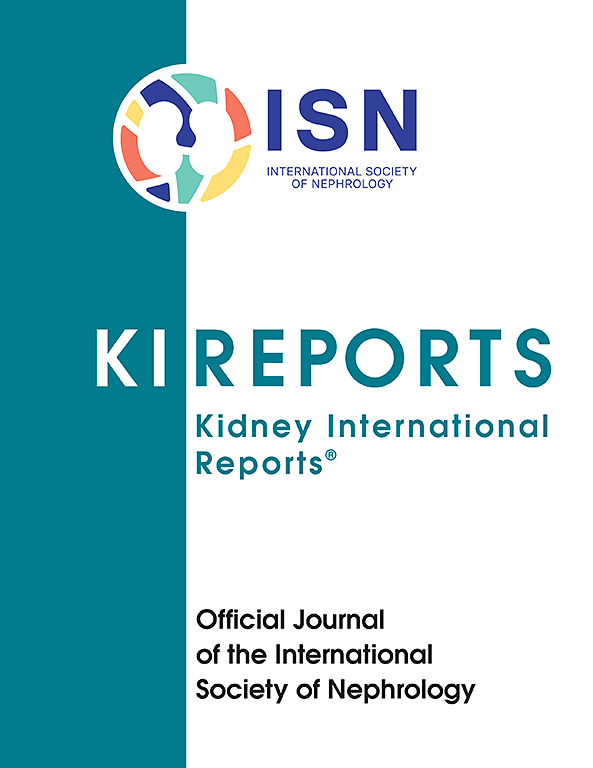Comprehensive Splice Pattern Analysis for Previously Reported OCRL Splicing Variants and Their Phenotypic Contributions
IF 5.7
2区 医学
Q1 UROLOGY & NEPHROLOGY
引用次数: 0
Abstract
Introduction
Two distinct phenotypes of Dent disease-2 and Lowe syndrome are caused by oculocerebrorenal syndrome of Lowe (OCRL) abnormality. Previous genetic studies demonstrated that truncating variants in exons 1 to 7 results in Dent disease-2 and in exons 8 to 24, result in Lowe syndrome. Recently, we successfully identified a functional OCRL isoform, whose altered initiation codons (Met187 and Met206) in exon 8 can affect the OCRL-truncating variant phenotypes. However, the association between OCRL splicing variants and phenotypes is poorly understood.
Methods
We performed a detailed splicing pattern analysis of previously reported 28 OCRL splicing variants obtained from the Human Gene Mutation Database. We assessed the variant consequences at the mRNA level using an in vitro splicing assay with a minigene system, and examined their compatibility with in silico algorithms and correlation with disease phenotypes.
Results
Aberrant splicing was confirmed in all 27 variants, except for 1, in which splicing could not be experimentally confirmed in the minigene system, and therefore could not be concluded with certainty. Splicing variants in OCRL exons 1 to 7 resulted in Dent disease-2, and in exons 9 to 24 resulted in Lowe syndrome. In 1 case, c.561-2 A > G in exon 8 demonstrated Dent disease-2.
Conclusion
This study provides significant data on the pathogenicity of OCRL splicing variants and genotype-phenotype correlations. In c.561-2 A > G, the latter altered initiation codon of the OCRL isoform (Met206) was preserved, potentially indicating the Dent disease-2 phenotype. This result supports our recent finding regarding the altered initiation codons in exon 8 of the OCRL isoform.

先前报道的OCRL剪接变异及其表型贡献的综合剪接模式分析
两种不同表型的Dent病-2和Lowe综合征是由ocococerebrorenal syndrome of Lowe (ocl)异常引起的。先前的遗传学研究表明,截断外显子1至7的变异会导致Dent病-2,而截断外显子8至24的变异会导致Lowe综合征。最近,我们成功地鉴定了一个功能性的ocl异构体,其在第8外显子的起始密码子(Met187和Met206)的改变可以影响ocl截断的变异表型。然而,ocl剪接变体与表型之间的关系尚不清楚。方法对人类基因突变数据库中已报道的28个OCRL剪接变体进行详细的剪接模式分析。我们使用带有minigene系统的体外剪接试验评估了mRNA水平上的变异后果,并检查了它们与计算机算法的兼容性以及与疾病表型的相关性。结果27个变异体均存在异常剪接,但有1个变异体的剪接在miniigene系统中未被实验证实,因此不能确定。ocl外显子1至7的剪接变异导致Dent病-2,外显子9至24的剪接变异导致Lowe综合征。在1例中,c. 562 -2 A >;外显子8的G表示凹痕病-2。结论本研究为研究ocl剪接变异的致病性和基因型-表型相关性提供了重要数据。在公元561-2年;G,后者改变的启动密码子ocl异构体(Met206)被保留,可能表明Dent病-2表型。这一结果支持了我们最近关于ocl异构体外显子8中起始密码子改变的发现。
本文章由计算机程序翻译,如有差异,请以英文原文为准。
求助全文
约1分钟内获得全文
求助全文
来源期刊

Kidney International Reports
Medicine-Nephrology
CiteScore
7.70
自引率
3.30%
发文量
1578
审稿时长
8 weeks
期刊介绍:
Kidney International Reports, an official journal of the International Society of Nephrology, is a peer-reviewed, open access journal devoted to the publication of leading research and developments related to kidney disease. With the primary aim of contributing to improved care of patients with kidney disease, the journal will publish original clinical and select translational articles and educational content related to the pathogenesis, evaluation and management of acute and chronic kidney disease, end stage renal disease (including transplantation), acid-base, fluid and electrolyte disturbances and hypertension. Of particular interest are submissions related to clinical trials, epidemiology, systematic reviews (including meta-analyses) and outcomes research. The journal will also provide a platform for wider dissemination of national and regional guidelines as well as consensus meeting reports.
 求助内容:
求助内容: 应助结果提醒方式:
应助结果提醒方式:


